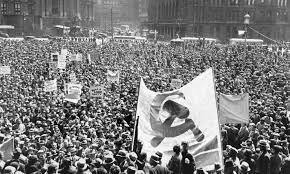The Movements of American Communism

Originally published at Counterpunch .
Joshua Morris
The Many Worlds of American Communism
Lexington Books: New York, 2022. 528 pp., $145.00
Far too often, scholars have mystified the history of theCommunist Party USA (CPUSA). Historians influenced by Cold War anticommunismsaw the CPUSA as a totalitarian import that was alien to American politicallife. In other words, it was the connection to the Soviet Union, not any socialstruggles that defined the CPUSA. Revisionist historians inspired by the NewLeft resisted this interpretation and highlighted the role of CPUSA militantsin struggles fighting racism, unemployment, and for social justice. Therevisionists told the history of the CPUSA as one of indigenous radicalismwhere the connection to the Soviet Union and communist ideology was downgraded.While there is a great deal to learn about the Communist Party from these twoschools, in practice they act as mirror images of each other, producing adistorted and one-sided portrait of history.
To understand the history of the CPUSA, it is necessary totake seriously the commitment by militants to the ideals of communism, laboractivism, and antiracism which is situated in a complex national andinternational context. Among the works that truly undertake this endeavor isJoshua Morris’ Many Worlds of American Communism. His account is writtenwith a balance of objectivity and sympathy, telling the story of the CPUSA fromits origins in 1919 through its early growing pains, and the height of itsinfluence in the 1930s and 40s through its decline after 1956. Many Worldsmanages to guide the reader through labor struggles, factional fighting, civilrights activism, and political repression. At times, both serious and funny, Morris’work is an impressive work of scholarship that synthesizes party documents,memoirs, and a vast array of secondary sources to give a big picture history ofthe Communist Party.
At the center of Morris’ approach is examining the role of communists asinvolved in multiple worlds of engagement as political activists, labororganizers, community organizers, etc. The CPUSA’s different worlds show thatit was a multifaceted movement and its militants came from many backgroundswith their own objectives. For example, political leaders were more focused ontheory and international questions than labor organizers who had to deal withlocal workers and the legal strategy around collective bargaining. Theexperiences of a black sharecropper in Alabama fighting the Klan, a Jewishtextile worker in New York City, or a theoretician in Chicago were differentworlds even if they fell under the same overall umbrella of communism.According to Morris, the existence of different worlds show that the party wasnot a monolith: “I assert that American communist history is not a history ofone political entity, nor is it a history of how certain ideologies had effectson the actions of certain influential individuals. It is a history of certainLeftists at the grassroots who chose to balance their lives between thepractical realities of American society and the ideals of Marxian socialism.”(viii)
This approach of multiple worlds is a valuable methodological tool forexplaining the roles and intersection between various areas of communist partylife and work. For instance, the “political world” of the CPUSA – especially inits first decade – was characterized by a high degree of factionalism. Despitetheir initial optimism, party leaders found that their efforts to implantrevolutionary doctrines in the United States were met with extreme hostilityand repression, causing them to turn inward as opposed to directing theirefforts outward into strikes and organizing. At the same time, the labor world– centered around dedicated trade unionists – found that their answers of howto organize unions and build the party differed from the political world. AsMorris notes: “By the start of the Communist Second Period in 1924, theAmerican communist movement possessed neither theoretical nor tactical factionsbut rather different worlds of experience—one deeply engrained in politicalsolutions to societal woes, and another dug into the day-to-day struggles ofthe American labor movement.” (50)
By the time of the Great Depression, the Communist Party had entered its ThirdPeriod where members believed that socialist revolution was just around thecorner. While the Third Period is associated with ultra-leftism, Morris observedit enabled the Communist Party to become a sizeable force on the American left.While activists were inspired by a revolutionary vision, its application variedamong the different communist worlds. The political world ran William Z. Fosterfor president in 1932 to spread a communist message across the country whileadvancing a series of practical demands to combat the crisis. Inaddition, members of the labor world “were encouraged to involve themselves inextra-party organizations, even if such organizations were amassed by nonpartymembers.” (209)
During the Third Period, the CPUSA saw capitalism as embroiled in such a deepcrisis that it was incapable of granting any fundamental reforms. This meantthat the party viewed every economic struggle as potentiallyrevolutionary. To win over the masses, the CPUSA adopted a “left”economist strategy by acting as the most resolute defenders of the economicneeds of the working class. By the end of the Third Period,communists proved to be among the most effective labor organizers who mobilizedthe masses far beyond their ranks.
While Morris does not deny that changes in political strategy were dictated inMoscow, he tends to emphasize the local experience of communists behind theseshifts over decisions made by Stalin and the Comintern. For instance, theadoption of the Popular Front in 1935 originated in the USSR, but he notes itsstrategy had support from domestic rank-and-file communists. The activists inthe labor and community worlds saw the Popular Front as a logical development ofthe mass initiatives that began during the Third Period: “Like the PoliticalWorld, communists active in labor organizing found little difficulty adaptingto the Popular Front line after 1934. In fact, many who had helped in keystrikes throughout the early 1930s developed the understanding of cooperativeorganizing strategies long before it was brought up by party leaders.” (282)
Party militants in the labor and community worlds followedComintern directives not solely due to ideology, but because the USSR’s viewsaligned with their experiences. In fact, activists in these worlds were morelikely to fight American party leaders than the Comintern, believing that theydictated struggle from afar and did not understand local conditions: “Ratherthan blindly accept the party line, communists at the grassroots showedresistance and hostility toward efforts by party leaders to dictate the needsof local labor struggles. The support seen by communist unionists for Cominternpolicies reflected less of an ideological commitment to international communismthan it did a perception that the Soviet’s understanding of class strugglealigned with their own.” (282)
While the community, labor, and political worlds were distinct, when they actedtogether it could produce dramatic results. For example, Communists playedcritical roles in the Flint sit down strike of 1936-1937 and the growth of theCongress of Industrial Organizations (CIO) into a mass industrial union. It wasduring these years that the labor world was characterized by a “focus onpractical needs and demands of the rank-and-file—not party politics.” (323) Thefocus on “practical politics” was shared by the CPUSA’s political world wherethe popular front necessitated an alliance with the forces of New Dealliberalism and the CIO’s leadership while dispensing with revolutionarypolitics. As a result, the Communist Party changed its strategy of “left” economismby dropping left pretensions and simply ending up as economist and reformist inits approach.
The CPUSA’s shift to economism meant that the political world of communism wasreduced to following the dictates of the USSR and seeking respectability athome. These two goals were not always compatible and found themselves at oddswhen Stalin signed a Non-Aggression Pact with Hitler in 1939. The party refusedto distance itself from the USSR and abandoned antifascist organizing, leadingto a decline in membership by 15%. When the line shifted again after the Germaninvasion of the USSR in 1941, party militants were glad that the previous moralambiguity was gone. Now they considered the defense of the Soviet Union as a“just war for the purpose of destroying fascism and defending the socialistmotherland.” (268)
As the political world with their goal of respectability gained ascendencyduring the war, this led to conflict with other communist worlds. In the laborworld, the CP’s support for the no-strike pledge “slowly broke down theeffectiveness of communist labor activism.” (333) While the community worldcontinued to struggle against racism during the war years (notably in the labormovement), the party’s standing among civil rights activists was harmed by thepolitical world in 1944. Earl Browder’s dissolution of the Communist Party intothe Communist Political Association was accompanied by a reversal of theparty’s long-standing stance on civil rights activism. Although the CPUSA wasreestablished the following year and reaffirmed its support for civil rights, permanentdamage had been done: “Unfortunately, the fight to rectify Browder’s policy oncivil rights and African American integration took far longer than it took toactually oust Browder and helped sever the Political World’s ties with itscommunity activists.” (409)
As Morris observed, the struggle over Browderism revealed the larger problem ofkeeping the labor, political, and community worlds of communism bound together.Many civil rights activists associated with communism believed they had to makea choice between fighting in their communities or maintaining party ties. As aresult, many were willing to cut their allegiance to the party since they werenot primarily motivated by ideology: “The moment the political dimension of themovement forced grassroots activists to decide between their morals and theirpolitical ideology, those who had come into the movement because of moral andethical alignment found little difficulty severing their connections with thePolitical World.” (409-410)
As a result of Cold War repression, internal strife, and revelations fromKhrushchev’s Secret Speech, the CPUSA’s membership declined. By the end of the 1950s,the party “was like a snake without a head.” (449) Now lacking a unifying politicalcenter, the labor and community worlds of communism went their separate ways. AsMorris argues, this did not represent a decline of communism, but a diffusionof its ideas on unions, civil rights, women’s liberation, etc. into new socialmovements and enduring to the present day:
Thoughthe many worlds of American Communism certainly faced increasing internal andexternal pressure during the postwar years, the only thing that declined duringthis era was the palatability of “communism” as a viable identity for activiststo rally behind. The ideas that were built during the 1920s, 1930s, and early1940s—that Americans deserved fair, equal, and safe workplaces; unemploymentprotections; the ability to bargain as a union with employers; an end to JimCrow; recognition of the unique nature of women’s oppression; socialunemployment paid for by increases in taxes on the wealthy; and an expansion ofthe New Deal program—remained not only dominant in the postwar era but alsowholly continued to evolve and produce new forms of activism by the 1960s.These concepts once ridiculed as “communist” in 1925 became championed byhundreds of thousands of civil rights activists less than 40 years later. Inthis way, American Communism continues to linger on today albeit without astrong ideological nucleus to bind the various worlds of experience together.(451)
It would be impossible for any history to be totallycomprehensive without becoming overly long. Yet there are some glaringomissions. The reader is left feeling underwhelmed at Morris’ discussion of thecultural world of American communism. What Michael Denning called the “CulturalFront” with its rich array of art, literature, music, and plays produced bythose in and around the Communist Party exercised an enduring influence onAmerican culture. Furthermore, another gap involves one of the darker areas ofparty history. While Morris does not shy away from the negative aspects ofCommunist Party history, he says very little about the party’s support forJapanese internment during World War II. Unfortunately, we do not learn how thevarious worlds of American communism dealt with this disgraceful episode.
All these criticisms aside, Morris succeeds in covering thebroad historical sweep of American communism. Analyzing the many worlds ofAmerican communism not only acknowledges the complexity experienced by partymilitants but breaks with the constraints of anticommunist and revisionistscholars who obscure a great deal of that history. Any radical who wants tolearn about the history of the Communist Party USA owes it to themselves topick up a copy of The Many Worlds of American Communism.



